Jianwei Fei
Unlocking the Capabilities of Vision-Language Models for Generalizable and Explainable Deepfake Detection
Mar 19, 2025Abstract:Current vision-language models (VLMs) have demonstrated remarkable capabilities in understanding multimodal data, but their potential remains underexplored for deepfake detection due to the misaligned of their knowledge and forensics patterns. To this end, we present a novel paradigm that unlocks VLMs' potential capabilities through three components: (1) A knowledge-guided forgery adaptation module that aligns VLM's semantic space with forensic features through contrastive learning with external manipulation knowledge; (2) A multi-modal prompt tuning framework that jointly optimizes visual-textual embeddings for both localization and explainability; (3) An iterative refinement strategy enabling multi-turn dialog for evidence-based reasoning. Our framework includes a VLM-based Knowledge-guided Forgery Detector (KFD), a VLM image encoder, and a Large Language Model (LLM). The VLM image encoder extracts visual prompt embeddings from images, while the LLM receives visual and question prompt embeddings for inference. The KFD is used to calculate correlations between image features and pristine/deepfake class embeddings, enabling forgery classification and localization. The outputs from these components are used to construct forgery prompt embeddings. Finally, we feed these prompt embeddings into the LLM to generate textual detection responses to assist judgment. Extensive experiments on multiple benchmarks, including FF++, CDF2, DFD, DFDCP, and DFDC, demonstrate that our scheme surpasses state-of-the-art methods in generalization performance, while also supporting multi-turn dialogue capabilities.
Robust Retraining-free GAN Fingerprinting via Personalized Normalization
Nov 09, 2023Abstract:In recent years, there has been significant growth in the commercial applications of generative models, licensed and distributed by model developers to users, who in turn use them to offer services. In this scenario, there is a need to track and identify the responsible user in the presence of a violation of the license agreement or any kind of malicious usage. Although there are methods enabling Generative Adversarial Networks (GANs) to include invisible watermarks in the images they produce, generating a model with a different watermark, referred to as a fingerprint, for each user is time- and resource-consuming due to the need to retrain the model to include the desired fingerprint. In this paper, we propose a retraining-free GAN fingerprinting method that allows model developers to easily generate model copies with the same functionality but different fingerprints. The generator is modified by inserting additional Personalized Normalization (PN) layers whose parameters (scaling and bias) are generated by two dedicated shallow networks (ParamGen Nets) taking the fingerprint as input. A watermark decoder is trained simultaneously to extract the fingerprint from the generated images. The proposed method can embed different fingerprints inside the GAN by just changing the input of the ParamGen Nets and performing a feedforward pass, without finetuning or retraining. The performance of the proposed method in terms of robustness against both model-level and image-level attacks is also superior to the state-of-the-art.
Wide Flat Minimum Watermarking for Robust Ownership Verification of GANs
Oct 25, 2023



Abstract:We propose a novel multi-bit box-free watermarking method for the protection of Intellectual Property Rights (IPR) of GANs with improved robustness against white-box attacks like fine-tuning, pruning, quantization, and surrogate model attacks. The watermark is embedded by adding an extra watermarking loss term during GAN training, ensuring that the images generated by the GAN contain an invisible watermark that can be retrieved by a pre-trained watermark decoder. In order to improve the robustness against white-box model-level attacks, we make sure that the model converges to a wide flat minimum of the watermarking loss term, in such a way that any modification of the model parameters does not erase the watermark. To do so, we add random noise vectors to the parameters of the generator and require that the watermarking loss term is as invariant as possible with respect to the presence of noise. This procedure forces the generator to converge to a wide flat minimum of the watermarking loss. The proposed method is architectureand dataset-agnostic, thus being applicable to many different generation tasks and models, as well as to CNN-based image processing architectures. We present the results of extensive experiments showing that the presence of the watermark has a negligible impact on the quality of the generated images, and proving the superior robustness of the watermark against model modification and surrogate model attacks.
Learning to mask: Towards generalized face forgery detection
Dec 29, 2022Abstract:Generalizability to unseen forgery types is crucial for face forgery detectors. Recent works have made significant progress in terms of generalization by synthetic forgery data augmentation. In this work, we explore another path for improving the generalization. Our goal is to reduce the features that are easy to learn in the training phase, so as to reduce the risk of overfitting on specific forgery types. Specifically, in our method, a teacher network takes as input the face images and generates an attention map of the deep features by a diverse multihead attention ViT. The attention map is used to guide a student network to focus on the low-attended features by reducing the highly-attended deep features. A deep feature mixup strategy is also proposed to synthesize forgeries in the feature domain. Experiments demonstrate that, without data augmentation, our method is able to achieve promising performances on unseen forgeries and highly compressed data.
General GAN-generated image detection by data augmentation in fingerprint domain
Dec 27, 2022Abstract:In this work, we investigate improving the generalizability of GAN-generated image detectors by performing data augmentation in the fingerprint domain. Specifically, we first separate the fingerprints and contents of the GAN-generated images using an autoencoder based GAN fingerprint extractor, followed by random perturbations of the fingerprints. Then the original fingerprints are substituted with the perturbed fingerprints and added to the original contents, to produce images that are visually invariant but with distinct fingerprints. The perturbed images can successfully imitate images generated by different GANs to improve the generalization of the detectors, which is demonstrated by the spectra visualization. To our knowledge, we are the first to conduct data augmentation in the fingerprint domain. Our work explores a novel prospect that is distinct from previous works on spatial and frequency domain augmentation. Extensive cross-GAN experiments demonstrate the effectiveness of our method compared to the state-of-the-art methods in detecting fake images generated by unknown GANs.
Learning Second Order Local Anomaly for General Face Forgery Detection
Sep 30, 2022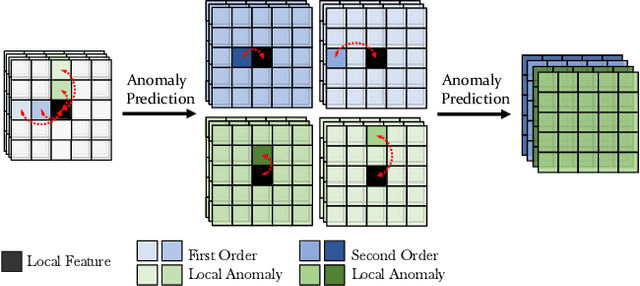
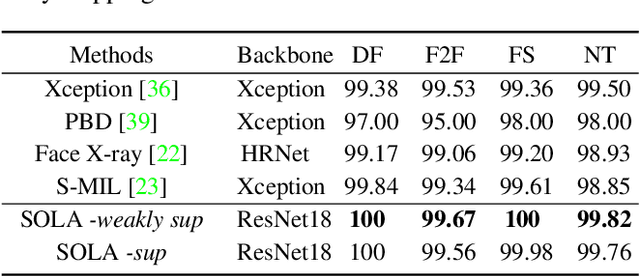
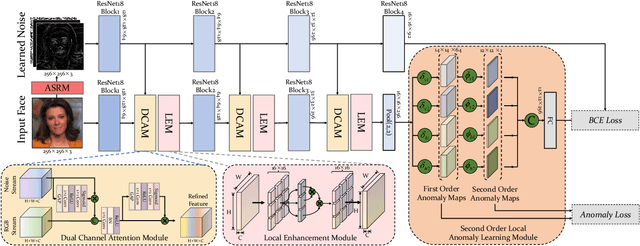
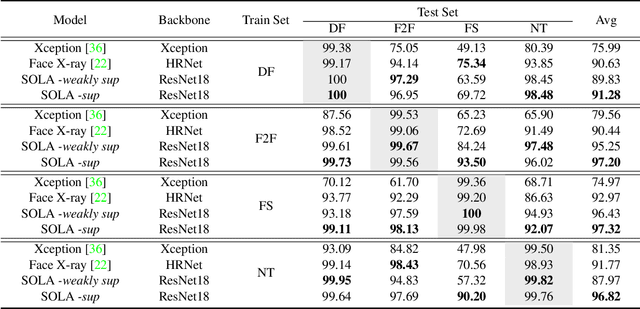
Abstract:In this work, we propose a novel method to improve the generalization ability of CNN-based face forgery detectors. Our method considers the feature anomalies of forged faces caused by the prevalent blending operations in face forgery algorithms. Specifically, we propose a weakly supervised Second Order Local Anomaly (SOLA) learning module to mine anomalies in local regions using deep feature maps. SOLA first decomposes the neighborhood of local features by different directions and distances and then calculates the first and second order local anomaly maps which provide more general forgery traces for the classifier. We also propose a Local Enhancement Module (LEM) to improve the discrimination between local features of real and forged regions, so as to ensure accuracy in calculating anomalies. Besides, an improved Adaptive Spatial Rich Model (ASRM) is introduced to help mine subtle noise features via learnable high pass filters. With neither pixel level annotations nor external synthetic data, our method using a simple ResNet18 backbone achieves competitive performances compared with state-of-the-art works when evaluated on unseen forgeries.
Supervised GAN Watermarking for Intellectual Property Protection
Sep 07, 2022



Abstract:We propose a watermarking method for protecting the Intellectual Property (IP) of Generative Adversarial Networks (GANs). The aim is to watermark the GAN model so that any image generated by the GAN contains an invisible watermark (signature), whose presence inside the image can be checked at a later stage for ownership verification. To achieve this goal, a pre-trained CNN watermarking decoding block is inserted at the output of the generator. The generator loss is then modified by including a watermark loss term, to ensure that the prescribed watermark can be extracted from the generated images. The watermark is embedded via fine-tuning, with reduced time complexity. Results show that our method can effectively embed an invisible watermark inside the generated images. Moreover, our method is a general one and can work with different GAN architectures, different tasks, and different resolutions of the output image. We also demonstrate the good robustness performance of the embedded watermark against several post-processing, among them, JPEG compression, noise addition, blurring, and color transformations.
A Robust Document Image Watermarking Scheme using Deep Neural Network
Feb 26, 2022
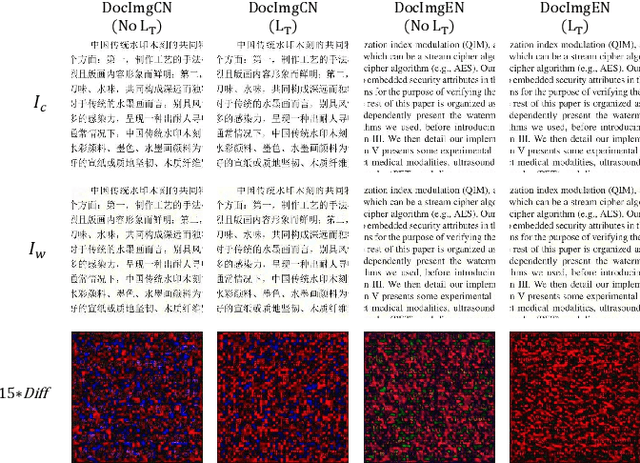
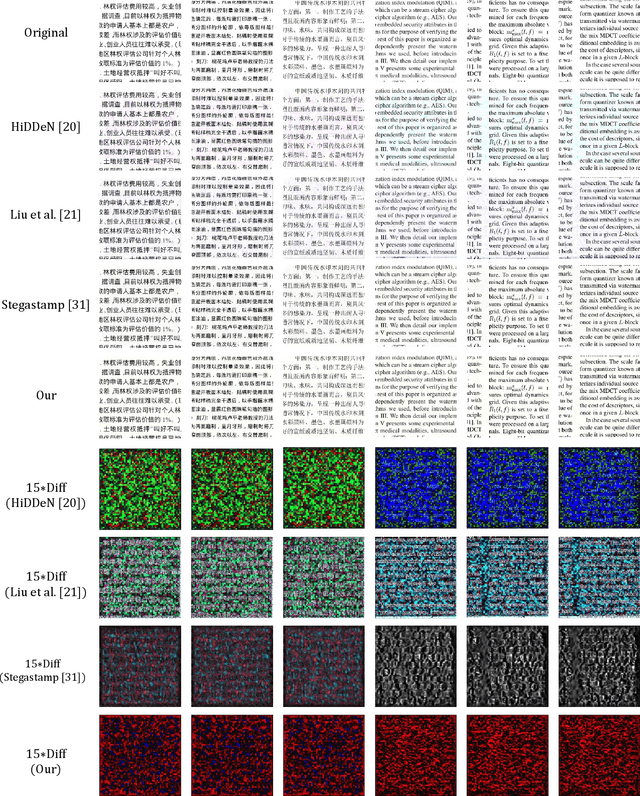
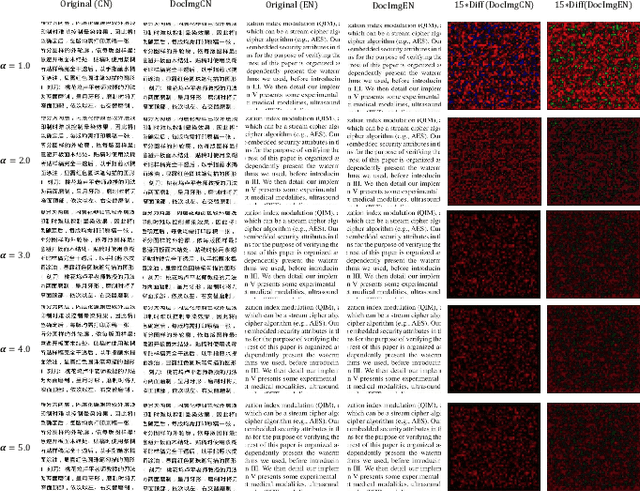
Abstract:Watermarking is an important copyright protection technology which generally embeds the identity information into the carrier imperceptibly. Then the identity can be extracted to prove the copyright from the watermarked carrier even after suffering various attacks. Most of the existing watermarking technologies take the nature images as carriers. Different from the natural images, document images are not so rich in color and texture, and thus have less redundant information to carry watermarks. This paper proposes an end-to-end document image watermarking scheme using the deep neural network. Specifically, an encoder and a decoder are designed to embed and extract the watermark. A noise layer is added to simulate the various attacks that could be encountered in reality, such as the Cropout, Dropout, Gaussian blur, Gaussian noise, Resize, and JPEG Compression. A text-sensitive loss function is designed to limit the embedding modification on characters. An embedding strength adjustment strategy is proposed to improve the quality of watermarked image with little loss of extraction accuracy. Experimental results show that the proposed document image watermarking technology outperforms three state-of-the-arts in terms of the robustness and image quality.
 Add to Chrome
Add to Chrome Add to Firefox
Add to Firefox Add to Edge
Add to Edge